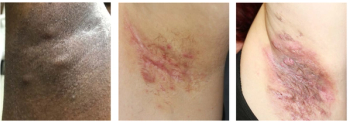
Evidence of Cumulative Life Course Impairment in Hidradenitis Suppurativa
Study data was presented at EADV 2022 regarding socioeconomic status related to HS.
Niamh Kearney, MB, research fellow in the department of dermatology at Belfast Health and Social Care Trust in Belfast, United Kingdom (UK), presented new study data on evidence for cumulative life course impairment in hidradenitis suppurativa (HS) at the European Academy of Dermatology and Venereology 2022 Congress in Milan, Italy. Kearney began her presentation by discussing socioeconomic status related to HS.
“We know that HS is associated with lower socioeconomic status, and this has been demonstrated using lower mean income/property values, increased Medicaid, and slower income growth. In Ireland, an estimated 30% of patients with HS are unemployed or receiving illness benefits. For those we are working, they lose about 16 workdays a year due to their disease, in addition to about 20% of productivity lost while at work,” said Kearney.
It remains unclear if HS causes downward social trajectories or if patients are born into a lower socioeconomic group.
Social drift describes downward social trajectories due to the development of the disease. Cumulative life course impairment (CLCI) is a model that adds to social drift by recognizing the continuous accumulation of disease burden with time, and the impact on quality of life and major life decisions. This places patients on different life trajectories from what they might have experienced in the absence of HS. Life course impairment is well documented in psoriasis, but it hasn’t been evaluated in HS. Although, patients with HS have described the disease in their own words as “putting the brakes on life.”
In the study, Kearney and her fellow investigators aimed to compare patient and parental highest educational attainment as a measure of social drift in HS. This was a cross-sectional, international study using an anonymous online survey that collected responses over 3 months. The information included basic demographics, Hurley stage, family history, disease duration, and HS treatments. Patients were asked about their employment status, personal highest educational attainment, and their parent's educational attainment.
The survey received 335 responses. The majority of participants were female with a median age of 38 years old. Approximately 1/3 of participants did not know their Hurley stage, but in 235 participants, it was predominately moderate-to-severe Hurley stages 2 & 3. The median disease duration was 15 years, and the median age at disease onset was 18 years old.
Responses were received from 10 different countries, with the USA, Ireland, and the UK as the top 3 countries. One-third of participants were not on any treatment for their HS, 25% received antibiotics, 20% were on biologics, and the remaining participants received treatments such as isotretinoin.
Employment status of HS survey participants:
- 24% were unemployed
- 11% received long-term illness benefits
- 4% received temporary illness benefits
- 48% were employed full-time
- 12% were employed part-time
Education level of HS survey participants:
- 100% completed primary/elementary school
- 98% completed junior certificate/middle school/ GCSEs
- 94% completed leaving certificate/high school/A-levels
- 71% completed post-leaving certificate/apprenticeship
- 41% completed an undergraduate degree
- 20% completed a postgraduate degree
- 10% completed a master's degree
- 2% completed a doctoral degree
Compared to parental education, participant education was greater at all levels except for paternal doctoral degrees. Using a chi-square test, this difference in educational attainment was statistically significant. Overall, the participant-level of educational attainment was higher than their parents.
“Thinking about the journey that’s experienced by patients with HS, the median age of onset is 19-23 years. This is a time in life when we think of it as the greatest time, post-school receiving education. Depending on the final Hurley stage, patients will progress into Hurley 2 or 3 over 5-6 years with the accumulation of disease burden. This moderate-to-severe disease in the mid-to-late 20s impacts work productivity, which impacts career progression, and employability,” said Kearney.
The study demonstrated for the first time that cumulative life course impairment is present in HS patients. The survey participants had high levels of educational attainment compared to the background population, but despite this, they were 3-10 times more likely to be unemployed, and 2-3 times more likely to receive illness benefits. CLCI may be preventing this cohort of highly educated patients from achieving their full employment potential. It requires further study to identify the factors involved in CLCI in HS, and whether medical professionals can reverse or prevent this with early diagnosis and intervention.
References:
- N. Kearney. Evidence for cumulative life course impairment in hidradenitis suppurativa: employment limitation despite high educational attainment. Presented at European Academy of Dermatology and Venereology 31st Annual Congress. August 7-10, 2022; Milan, Italy.
Newsletter
Like what you’re reading? Subscribe to Dermatology Times for weekly updates on therapies, innovations, and real-world practice tips.

















